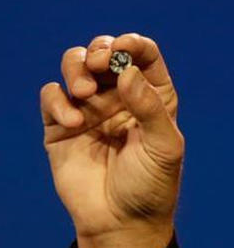Intel CEO Krzanich unveils wearable processor Curie


Much of Krzanich's talk revolved around positioning the chip maker as an innovator and brain for the next generation of computing.
Krzanich's talk showcased Intel's present, midterm and long-term roadmap. The present revolves around RealSense, which is a voice and gesture control system. Naturally, Intel sees its processors everywhere. Most of the demonstrations during Krzanich's keynote at CES 2015 had been touched on in 2014. Intel demonstrated RealSense as well as its robotics capabilities in events over the summer.
In addition, HP said that Intel processors will power its future 3D printing system, which won't be available until 2016.
Here's a rundown of the technologies, Krzanich noted. The overarching theme from Intel was that its RealSense technology can aid computer vision for everything from desktops to drones.
Available this year
RealSense. Voice and gesture control embedded in a bevy of laptops and tablets. Lenovo's Yoga was used in a demo and Dell's Venue tablet was highlighted. "You'll no longer be chained to your computer by wires," said Krzanich. RealSense has been highlighted for months, but is now being rolled out in enough devices for critical mass.
Wireless connections. Krzanich covered technology highlighted at the Intel Developers Conference called WiGi, which is a way of connecting your laptop to a display, keyboard, mouse without wires. Wireless charging is also available through the technology. Intel has partnered with Marriott, Hilton, San Francisco airport and others to offer wireless charging.
Wearables. Intel noted that it introduced Edison, a computer the size of a postage stamp designed for wearables. Krzanich unveiled Curie, a computer about the size of a suit button. Intel's wearable strategy revolves around partnerships. Curie is just out of the labs and a prototype, but will land in the second half of 2015. "This changes the game on wearables," he said.
Intermediate term
3D and blended reality. Krzanich handed the stage to Dion Weisler, executive vice president of Hewlett-Packard and future CEO of the consumer half of the company when it splits. Weisler highlighted Sprout, a blended reality computer, as well as HP's 3D printer, which won't arrive until 2016. The message of Sprout is that immersive computing is powered by Intel's processors and RealSense. Weisler also said that HP's future Multi Jet Fusion 3D printer will be powered by Intel's Core processor.
Long term
Holographic displays, which are powered by RealSense. The idea is to go beyond the touchscreen and be able to play a virtual piano.
Intelligence everywhere. "Everything that was once standalone is now becoming smart and connected," said Krzanich. Intel's CEO highlighted how the company could integrate security and RealSense in ADP security systems. Think authentication to get into your house.
Robotics. Krzanich highlighted a partnership with iRobot and the Ava collaboration robot, which was developed with Cisco. Intel chips and RealSense technology are integrated. Krzanich also highlighted drones that use RealSense technology as well as Intel processors. It's worth noting ARM's latest Cortex M7 processor was designed in part to power the Internet of things and drones.